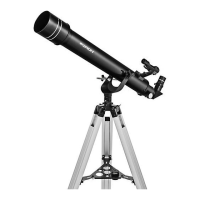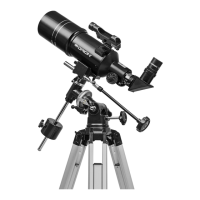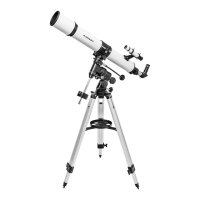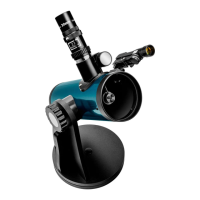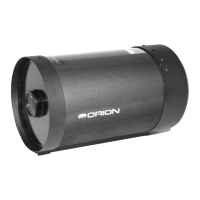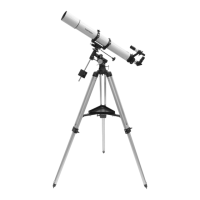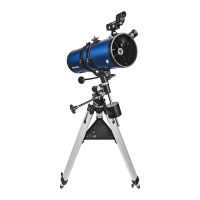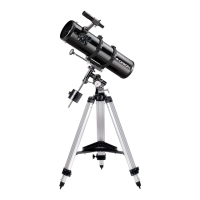with the Earth’s rotational (polar) axis—a process called polar
alignment.
Understanding Polar Alignment
To understand what you will be doing when polar aligning,
look at Figures 7 and 8. The exaggerated telescope mount in
Figure 7 shows how you will be aligning the Right Ascension
axis (shown in Figure 3a) so that it is parallel to the Earth’s
axis and pointing towards the North Star (Polaris). Figure 8
shows what the polar alignment will mean in terms of your
location on the Earth and other reference points.
The reason for polar alignment is a little tricky to understand;
since the Earth is rotating, stars are moving across the sky in
an arc pattern for most of the world. If you were standing at
the North or South Poles (and were at the top of the rotating
globe), the stars would move in a circular pattern overhead,
never rising or setting. If you were standing on the equator,
the stars would move in straight line overhead. If you faced
east, a star that rose directly in front of you would set directly
behind you in the West.
However, most of us live at a place on the Earth where the
stars rise at one point in the East, move across part of the sky,
and set at a different part of the Western horizon. This means
that if you were to use an ordinary tripod (which moves in up/
down and left/right motions) to mount your telescope, you
would have a hard time “tracking” stellar objects. This is where
an equatorial mount has the advantage, it may take a little lon-
ger to set up, but the effort is worth it. Don’t be intimidated by
the setting circles and knobs. It’s actually easier to do than you
might think! Once you’ve practiced a few times, you’ll be able
to set up the equatorial mount easily.
Polar Alignment
For Northern Hemisphere observers, approximate polar align-
ment is achieved by pointing the mount’s R.A. axis at Polaris
(also called the North Star). It lies within 1° of the north celes-
tial pole (NCP), which is an extension of the Earth’s rotational
axis out into space. Stars in the Northern Hemisphere appear
to revolve around the NCP.
To find Polaris in the sky, look north and locate the pattern of
the Big Dipper (Figure 9). The two stars at the end of the
“bowl” of the Big Dipper point right to Polaris.
Observers in the Southern Hemisphere aren’t so fortunate to
have a bright star so near the south celestial pole (SCP). The
star Sigma Octantis lies about 1° from the SCP, but it is barely
visible with the naked eye (magnitude 5.5).
To polar-align the Observer 70 EQ:
1. Level the equatorial mount (5) by adjusting the length of
the three tripod legs (10).
Figure 9. To find Polaris in the night sky, look north and find the
Big Dipper. Extend an imaginary line from the two "Pointer Stars" in
the bowl of the Big Dipper. Go about five times the distance
between those stars and you'll reach Polaris, which lies within 1° of
the north celestial pole (NCP).
13
Figure 7. When properly polar-aligned, the equatorial mount can
easily “track” objects by compensating for the rotation of the earth.
to Polaris
C
e
l
e
s
t
i
a
l
E
q
u
a
t
o
r
E
q
u
a
t
o
r
EQ mount moves in the opposite
direction of the Earth's rotation.
Right Ascension Axis
Figure 8. Polar alignment of the Observer 70 EQ is easily done
by pointing the telescope’s right ascension axis at Polaris (The
North Star).
R
ight AscensionAxi
s
9
0
ϒ
P
o
l
e
t
o
E
q
u
a
t
o
r
Polaris
(The North Star)
Celestial
Equator
Horizon
Angle from the ground
to the North Star is the
same as your latitude.
Your EQ mount's latitude
should match this angle.
S N
E
W
S
E
W
N
Big Dipper
(in Ursa Major)
Little Dipper
(in Ursa Minor)
Cassiopeia
N.C.P.
Pointer
Stars
Polaris
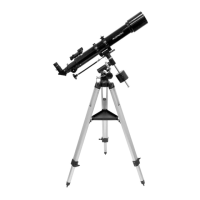
